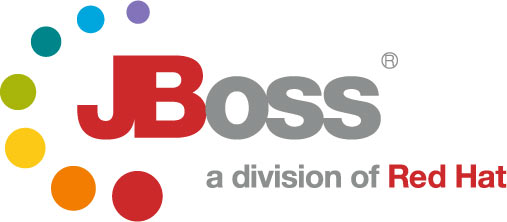
JBESB-PG-

Legal Notices
The information contained in this documentation is subject to change without notice.
JBoss Inc. makes no warranty of any kind with regard to this material, including, but not limited to, the implied warranties of merchantability and fitness for a particular purpose. JBoss Inc. shall not be liable for errors contained herein or for incidental or consequential damages in connection with the furnishing, performance, or use of this material.
Java™ and J2EE is a U.S. trademark of Sun Microsystems, Inc. Microsoft® and Windows NT® are registered trademarks of Microsoft Corporation. Oracle® is a registered U.S. trademark and Oracle9™, Oracle9 Server™ Oracle9 Enterprise Edition™ are trademarks of Oracle Corporation. Unix is used here as a generic term covering all versions of the UNIX® operating system. UNIX is a registered trademark in the United States and other countries, licensed exclusively through X/Open Company Limited.
Copyright
JBoss, Home of Professional Open Source Copyright 2006, JBoss Inc., and individual contributors as indicated by the @authors tag. All rights reserved.
See the copyright.txt in the distribution for a full listing of individual contributors. This copyrighted material is made available to anyone wishing to use, modify, copy, or redistribute it subject to the terms and conditions of the GNU General Public License, v. 2.0. This program is distributed in the hope that it will be useful, but WITHOUT A WARRANTY; without even the implied warranty of MERCHANTABILITY or FITNESS FOR A PARTICULAR PURPOSE.
See the GNU General Public License for more details. You should have received a copy of the GNU General Public License, v. 2.0 along with this distribution; if not, write to the Free Software Foundation, Inc., 51 Franklin Street, Fifth Floor, Boston, MA 02110-1301, USA.
Software Version
JBoss ESB 4.0 GA RC1
Restricted Rights Legend
Use, duplication, or disclosure is subject to restrictions as set forth in contract subdivision (c)(1)(ii) of the Rights in Technical Data and Computer Software clause 52.227-FAR14.
©
Copyright
Contents
Table of Contents
Contents iv
About This Guide 5
What This Guide Contains 5
Audience 5
Prerequisites 5
Organization 5
Documentation Conventions 5
Additional Documentation 6
Contacting Us 6
Service Oriented Architecture 8
Overview 8
Why SOA? 10
Basics of SOA 11
Advantages of SOA 12
Interoperability 12
Efficiency 12
Standardization 13
The Enterprise Service Bus 14
Overview 14
Architectural requirements 16
Registries and repositories 17
Versioning of Services 17
Incorporating legacy services 17
When to use JBossESB 19
Introduction 19
JBossESB 23
Rosetta 23
The core of JBossESB in a nutshell 24
JBossESB components 25
Configuration 25
The Message Store 26
ESB-aware and ESB-unaware users 26
Endpoint References 27
Gateways to the ESB 28
The Message 29
The Message Header 32
The Message payload 33
The MessageFactory 34
Message Formats 35
MessageType.JAVA_SERIALIZED 36
MessageType.JBOSS_XML 36
Data Transformation 36
Listener, Courier and Action Classes 37
Configuration 41
Overview 41
Index 42
About This Guide
The Programmers Guide contains descriptions on the principles behind Service Oriented Architecture and Enterprise Service Bus, as well as how they relate to JBossESB. This guide also contains information on how to use JBoss ESB 4.0 GA RC1.
This guide is most relevant to engineers who are responsible for using JBoss ESB 4.0 GA RC1 installations and want to know how it relates to SOA and ESB principles.
None.
This guide contains the following chapters:
Chapter 1, What is SOA?: JBossESB is a SOA infrastructure. This chapter gives an overview of SOA and the benefits it can provide.
Chapter 2, The Enterprise Service Bus: an overview of what constitutes an ESB and how JBossESB may differ from traditional ESB definitions.
Chapter 3, JBossESB core: a description of the core components within JBossESB and how they are intended to be used.
Chapter 4, Configuration: a description of the configuration options within JBossESB.
The following conventions are used in this guide:
|
Convention |
Description |
|
Italic |
In paragraph text, italic identifies the titles of documents that are being referenced. When used in conjunction with the Code text described below, italics identify a variable that should be replaced by the user with an actual value. |
|
Bold |
Emphasizes items of particular importance. |
|
Code |
Text that represents programming code. |
|
Function | Function |
A path to a function or dialog box within an interface. For example, “Select File | Open.” indicates that you should select the Open function from the File menu. |
|
( ) and | |
Parentheses enclose optional items in command syntax. The vertical bar separates syntax items in a list of choices. For example, any of the following three items can be entered in this syntax: persistPolicy (Never | OnTimer | OnUpdate | NoMoreOftenThan) |
|
Note: |
A note highlights important supplemental information. A caution highlights procedures or information that is necessary to avoid damage to equipment, damage to software, loss of data, or invalid test results. |
Table 1 Formatting Conventions
In addition to this guide, the following guides are available in the JBoss ESB 4.0 GA RC1 documentation set:
JBoss ESB 4.0 GA RC1 Trailblazer Guide: Provides guidance for using the trailblazer example.
JBoss ESB 4.0 GA RC1 Getting Started Guide: Provides a quick start reference to configuring and using the ESB.
JBoss ESB 4.0 GA RC1 Configuring Hypersonic Guide: This is necessary for setting up the Hypersonic database if you want to use it within the trailblazer.
Questions or comments about JBoss ESB 4.0 GA RC1 should be directed to our support team.
Chapter 1
Service Oriented Architecture
JBossESB is a Service Oriented Architecture (SOA) infrastructure. SOA represents a popular architectural paradigm1 for applications, with Web Services as probably the most visible way of achieving an SOA2. Web Services implement capabilities that are available to other applications (or even other Web Services) via industry standard network and application interfaces and protocols. SOA advocates an approach in which a software component provides its functionality as a service that can be leveraged by other software components. Components (or services) represent reusable software building blocks.
SOA allows the integration of existing systems, applications and users into a flexible architecture that can easily accommodate changing needs. Integrated design, reuse of existing IT investments and above all, industry standards are the elements needed to create a robust SOA.
As enterprises slowly emerge from the mad rush of cost reduction into a more stable period of cost management, many of them find themselves in unfamiliar territory. Prior to the economic slow down, most firms understood the options they had for IT investment. Many embarked on major package implementations (e.g., Siebel, Peoplesoft and so on), while others built on the legacy systems they have trusted for years. Either way, most firms recognized the return promised and made the investment. Today, the appetite for such large investment is gone.
However, enterprises still need to make forward progress and keep ahead of the competition. SOA (and typically Web Services as a concrete implementation of those principles) make this possible. The result is dramatic improvements in collaboration between users, applications and technology components, generating significant value for any business creating competitive advantage.
Imagine a company that has existing software from a variety of different vendors, e.g., SAP, PeopleSoft. Some of these software packages may be useful to conduct business with other companies (customers, suppliers, etc.) and therefore what the company would like to do is to take those existing systems and make them available to other companies, by exposing them as services. A service here is some software component with a stable, published interface that can be invoked by clients (other software components). So, requesting and executing services involves software components owned by one company talking to components owned by another company, i.e., business-to-business (B2B) transactions.
Conventional distributed system infrastructures (middleware) are not sufficient for these cross-organizational exchanges. For instance
You would need agreement between the parties involved on the middleware platform
There is an implicit (and sometimes explicit) lack of trust between the parties involved.
Business data is confidential and should only to be seen by the intended recipient.
Many assumptions of conventional middleware are invalid in cross-organizational interactions. Transactions, for instance, last longer - possibly for hours or days so conventional transaction protocols such as two phase commit are not applicable.
So, in B2B exchanges the lack of standardization across middleware platforms makes point-to-point solutions costly to realize in practice. The Internet alleviated some of these problems by providing standard interaction protocols (HTTP) and data formats (XML) but by themselves these standards are not enough to support application integration. They don't define interface definition languages, name and directory services, transaction protocols, etc,. It is the gap between what the Web provides and what application integration requires that Web services are trying to fill.
However, whilst the challenge and ultimate goal of SOA is inter-company interactions, services do not need to be accessed through the Internet. They can be made available to clients residing on a local LAN. Indeed, at this current moment in time, many Web services are being used in this context - intra-company integration rather than inter-company exchanges.
An example of how Web services can connect applications both intra-company and inter-company can be understood by considering a stand-alone inventory system. If you don't connect it to anything else, it's not as valuable as it could be. The system can track inventory, but not much more. Inventory information may have to be entered separately in the accounting and customer relationship management systems. The inventory system may be unable to automatically place orders to suppliers. The benefits of such an inventory system are diminished by high overhead costs.
However, if you connect your inventory system to your accounting system with XML, it gets more interesting. Now, whenever you buy or sell something, the implications for your inventory and your cash flow can be tracked in one step. If you go further, and connect your warehouse management system, customer ordering system, supplier ordering systems, and your shipping company with XML, suddenly that inventory management system is worth a lot. You can do end-to-end management of your business while dealing with each transaction only once, instead of once for every system it affects. A lot less work and a lot less opportunity for errors. These connections can be made easily using Web services.
Businesses are waking up to the benefits of SOA. These include:
opening the door to new business opportunities by making it easy to connect with partners;
saving time and money by cutting software development time and consuming a service created by others;
increasing revenue streams by easily making your own services available.
The problem space can be categorized by past IT investments in the area of eProcurement, eSourcing, Supply Chain Management, Customer Relationship Management (CRM) and Internet computing in general. All of these investments were made in a silo. Along with the incremental growth in these systems to meet short-term (tactical) requirements, the decisions made in this space hurt the long-term viability of the applications and infrastructure.
The three key drivers for implementing an SOA approach are:
Cost Reduction: Achieved by the ways services talk to each other. The direct cost effect is delivered through enhanced operations productivity, effective sourcing options, and a significantly enhanced ability to shift ongoing costs to a variable model.
Delivering IT solutions faster and smarter: A standards based approach will allow organizations to connect and share information and business processes much faster and easier than before. IT delivery productivity is markedly improved through simplification of the developer’s role by providing standard frameworks and interfaces. Delivery timescales have been drastically reduced by easing the integration load of individual functionality, and applying accelerated delivery techniques within the environment.
Maximizing return on investment: Web Services opens the way for new business opportunities by enabling new business models. Web Services present the ability to measure value and discrete return much differently than traditional functional-benefit methods. Typical Total Cost of Ownership (TCO) models do not take into account the lifetime value generated by historical investment. This cost centric view destroys many opportunities to exploit these past investments and most enterprises end up building redundancy into their architecture, not out of necessity, but of perceived need. These same organizations focus the value proposition of their IT investment on a portfolio of applications, balanced by the overhead of infrastructure. An approach based on Web Services takes into account the lifetime contribution of legacy IT investment and promotes an evolution of these investments rather than a planned replacement.
SOA/Web Services fundamentally changes the way enterprise software is developed and deployed. SOA has evolved where new applications will not be developed using monolithic approaches, but instead become a virtualized on-demand execution model that breaks the current economic and technological bottleneck caused by traditional approaches.
Software as a service has become pervasive as a model for forward looking enterprises to streamline operations, lower cost of ownership and provides competitive differentiation in the marketplace. Web Services offers a viable opportunity for enterprises to drive significant costs out of software acquisitions, react to rapidly changing market conditions and conduct transactions with business partners at will. Loosely coupled, standards-based architectures are one approach to distributed computing that will allow software resources available on the network to be leveraged. Applications that separate business processes, presentation rules, business rules and data access into separate loosely coupled layers will not only assist in the construction of better software but also make it more adaptable to future change.
SOA will allow for combining existing functions with new development efforts, allowing the creation of composite applications. Leveraging what works lowers the risks in software development projects. By reusing existing functions, it leads to faster deliverables and better delivery quality.
Loose coupling helps preserve the future by allowing parts to change at their own pace without the risks linked to costly migrations using monolithic approaches. SOA allows business users to focus on business problems at hand without worrying about technical constraints. For the individuals who develop solutions, SOA helps in the following manner:
Business analysts focus on higher order responsibilities in the development lifecycle while increasing their own knowledge of the business domain.
Separating functionality into component-based services that can be tackled by multiple teams enables parallel development.
Quality assurance and unit testing become more efficient; errors can be detected earlier in the development lifecycle
Development teams can deviate from initial requirements without incurring additional risk
Components within architecture can aid in becoming reusable assets in order to avoid reinventing the wheel
Functional decomposition of services and their underlying components with respect to the business process helps preserve the flexibility, future maintainability and eases integration efforts
Security rules are implemented at the service level and can solve many security considerations within the enterprise
Traditional distributed computing environments have been tightly coupled in that they do not deal with a changing environment well. For instance, if an application is interacting with another application, how do they handle data types or data encoding if data types in one system change? How are incompatible data-types handled?
The service-oriented architecture (SOA) consists of three roles: requester, provider, and broker.
Service Provider: A service provider allows access to services, creates a description of a service and publishes it to the service broker.
Service Requestor: A service requester is responsible for discovering a service by searching through the service descriptions given by the service broker. A requester is also responsible for binding to services provided by the service provider.
Service Broker: A service broker hosts a registry of service descriptions. It is responsible for linking a requestor to a service provider.
SOA provide several significant benefits for distributed enterprise systems. Some of the most notable benefits include: interoperability, efficiency, and standardization. We will briefly explore each of these in this section.
Interoperability is the ability of software on different systems to communicate by sharing data and functionality. SOA/Web Services are as much about interoperability as they are about the Web and Internet scale computing. Most companies will have numerous business partners throughout the life of the company. Instead of writing a new addition to your applications every time you gain a new partner, you can write one interface using Web service technologies like SOAP. So now your partners can dynamically find the services they need using UDDI and bind to them using SOAP. You can also extend the interoperability of your systems by implementing Web services within your corporate intranet. With the addition of Web services to your intranet systems and to your extranet, you can reduce the cost integration, increase communication and increase your customer base.
It is also important to note that the industry has even established the Web Services Interoperability Organization.
“The Web Services Interoperability Organization is an open industry effort chartered to promote Web Services interoperability across platforms, applications, and programming languages. The organization brings together a diverse community of Web services leaders to respond to customer needs by providing guidance, recommended practices, and supporting resources for developing interoperable Web services.” (www.ws-i.org)
The WS-I will actually determine whether a Web service conforms to WS-I standards as well as industry standards. In order to establish integrity and acceptance, companies will seek to build their Web services in compliance with the WS-I standards.
SOA will enable you to reuse your existing applications. Instead of creating totally new applications, you can create them using various combinations of services exposed by your existing applications. Developers can be more efficient because they can focus on learning industry standard technology. They will not have to spend a lot of time learning every new technology that arises. For a manager this means a reduction in the cost of buying new software and having to hire new developers with new skill sets. This approach will allow developers to meet changing business requirements and reduce the length of development cycles for projects. Overall, SOA provides for an increase in efficiency by allowing applications to be reused, decreasing the learning curve for developers and speeding up the total development process.
For something to be a true standard, it must be accepted and used by the majority of the industry. One vendor or small group of vendors must not control the evolution of the technology or specification. Most if not all of the industry leaders are involved in the development of Web service specifications. Almost all businesses use the Internet and World Wide Web in one form or another. The underlying protocol for the WWW is of course HTTP. The foundation of Web services is built upon HTTP and XML. Although SOA does not mandate a particular implementation framework, interoperability is important and SOAP is one of the few protocols that all good SOA implementations can agree on.
Chapter 2
The Enterprise Service Bus
The ESB is seen as the next generation of EAI – better and without the vendor-lockin characteristics of old. As such, many of the capabilities of a good ESB mirror those of existing EAI offerings. Traditional EAI stacks consist of: Business Process Monitoring, Integrated Development Environment, Human Workflow User Interface, Business Process Management, Connectors, Transaction Manager, Security, Application Container, Messaging Service, Metadata Repository, Naming and Directory Service, Distributed Computing Architecture.
As with EAI systems, ESB is not about business logic – that is left to higher levels. It is about infrastructure logic. Although there are many different definitions of what constitutes an ESB, what everyone agrees on now is that an ESB is part of an SOA infrastructure. However, SOA is not simply a technology or a product: it's a style of design, with many aspects (such as architectural, methodological and organisational) unrelated to the actual technology. But obviously at some point it becomes necessary to map the abstract SOA to a concrete implementation and that's where the ESB comes in to play.
By considering ESB in terms of an SOA infrastructure, then we have the flexibility to abstract away from given implementation choices, such as JMS, SOAP etc. Then we define the capabilities that we want from our SOA infrastructure, which become the capabilities for the ESB. However, because of their heritage, ESBs typically come with a few assumptions that are not inherent to SOA:
Java specific.
Run-time message mediator.
Message translation.
Security model translation.
Loose coupling does not require a mediator to route messages, although that is dominant ESB architecture. This is also a requirement within the JBI specification. The ESB model should not restrict the SOA model, but should be seen as a concrete representation of SOA. As a result, if there is a conflict between the way SOA would approach something and the way in which is may be done in a traditional ESB, the SOA approach will win within JBossESB.
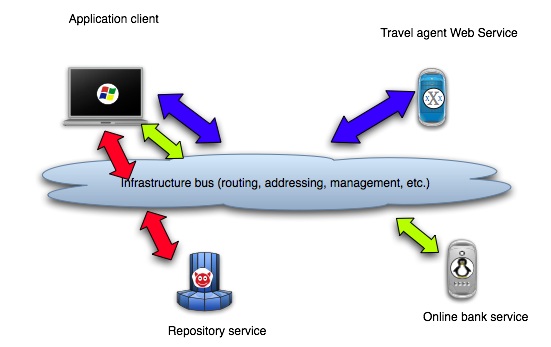
Therefore, in JBossESB mediation (e.g., content based routing) is a deployment choice and not a mandatory requirement. Obviously for compliance with certain specifications it may be configured by default, but if developers don't need that compliance point, they should be able to remove it (generally or on a per service basis).
The abstract view of the ESB/SOA infrastructure is shown below in Figure 1:
At its core, a good SOA should have a good messaging infrastructure (MI), and JMS is a fairly good example of a standards-compliant MI. But it obviously will not be the only implementation supported. Other capabilities that an ESB provides include:
Process orchestration, typically via WS-BPEL.
Protocol translation.
Adapters.
Change management (hot deployment, versioning, lifecycle management).
Quality of service (transactions, failover).
Qualify of protection (message encryption, security).
Management.
Access control lists (ACLs) are important and complimentary to security protocols, such as WS-Security/WS-Trust, and often overlooked by existing implementations. JBossESB will support ACLs are part of the security capabilities.
Many of these capabilities can be obtained by plugging in other services or layering existing functionality on the ESB. We should see the ESB as the fabric for building, deploying and managing event-driven SOA applications and systems. There are many different ways in which these capabilities can be realised and JBossESB does not mandate one implementation over another. Therefore, all capabilities will be accesses as services which will give plug-and-play configurability and extensibility options.
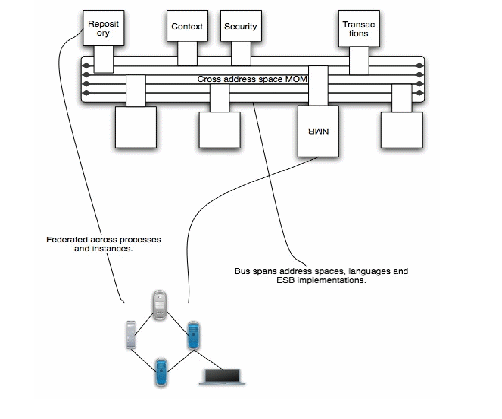
Figure 2: ESB components and multi-bus support.
In a distributed environment services can communicate with each other using a variety of message passing protocols. With the aid of client and server stub code, RPC semantics can be used to maintain the abstraction of local procedure calls across address space boundaries. Client stub code is a local proxy for the remote object, which is controlled by the corresponding server stub code. It is the responsibility of the client stub to marshal information which identifies the remote method and its parameters, transmit this information across the network to the object, receive the reply message, and unmarshal the reply to return to the invoker.
However, SOA does not imply a specific carrier protocol and neither does it imply RPC semantics (in fact, loose coupling of services forces developers into an asynchronous message passing pattern3). Therefore, multiple protocols should be supported simultaneously. In most cases, clients will know the communication protocol to use when interacting with a service; however, in some situations this may not be the case, and the communication stack may need to be assembled dynamically (via a hand-shake protocol, where the client stub may have to be dynamically constructed4).
At the core of JBossESB is a messaging infrastructure (MI), but this MI is abstract, in that it will does not force us into just JMS or SOAP styles. For example, a pure-play Web Services deployment within the ESB can be supported. As such, JBossESB assumes a single MI abstraction, but the capabilities may be provided by multiple different implementations. This is further support for the notion of having multiple buses within the ESB (each bus may be controlled by a separate MI implementation).
The service description and service contract are extremely important in the context of SOA and therefore ESB. In general, the developers create the contracts and the ESB maps it to whatever technology is being used to implement the SOA, e.g., WSDL. JBossESB allows this mapping to technology to be configurable and dynamic, i.e., it supports multiple SOA implementation technologies.
There are actually two different aspects to the service bus: first, turning legacy systems and services into services that work within the SOA infrastructure; secondly, there is taking the services and adding policy and mediation control between those services. Integral to this is the notion of SOA Repositories: a repository is a persistent representation of an SOA Registry, which is needed to publish, discover and consume services. JBossESB will support a range of registry implementations, with UDDI as one of the first.
Using the ESB/SOA actually consists of two phases: the initial creation phase and the maintenance phase, which may have different requirements from the creation phase. Services evolve over time and it is often difficult or impossible to find a quiescent period in which to replace a service. As such, in any enterprise deployment there is likely going to be multiple versions of services being used by clients at the same time. Some of the version mismatch may be hidden by suitable routing and on-the-fly message modifications. JBossESB will address the challenge of versioning of services, something that other implementations tend to ignore. Services will be identifiable via major and minor version numbers, with pattern matching capabilities provided by a pluggable rules engine, e.g., a default rule would be that all minor versions are compatible within the scope of the same major version number, but that can be overridden with a specific rule by the service provider or system administrator.
One of the key aspects of SOA is the ability to leverage existing infrastructural investments. Being required to cast aside software systems in order to incorporate a new technology such as an ESB, is not good practice and we would caution against using such systems since they could lead to vendor lock-in.
JBossESB will allow existing services to be incorporated within the ESB environment without modification to those services. Likewise, clients and services that are deployed within JBossESB will be able to use services that are external to the ESB in an automatic manner. This is illustrated in the figure below and explained in more detail in subsequent chapters.
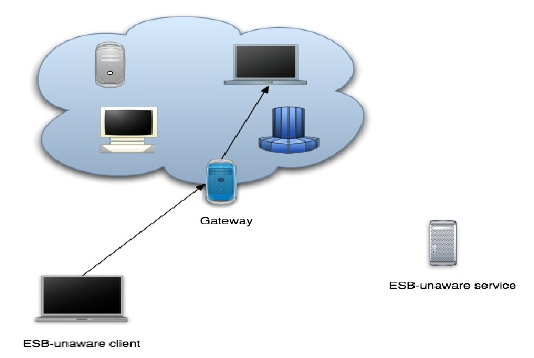
Chapter 3
When to use JBossESB
We have already discussed when SOA principles and an ESB implementation may be useful. The table below illustrates some further, concrete examples where JBossESB would be useful. Although these examples are specific to interactions between participants using non-interoperable JMS implementations, the principles are general.
The diagram below shows simple file movement between two systems where messaging queuing is not involved.

The next diagram illustrates how transformation can be injected into the same scenario using JBossESB.
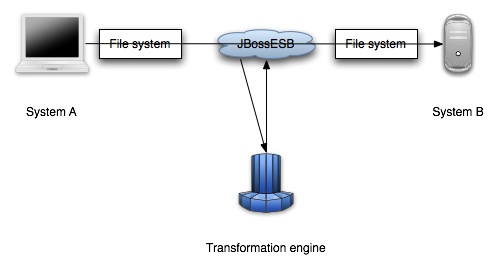
In the next series of examples, we use a queuing system (e.g., a JMS implementation).

The diagram below shows transformation and queuing in the same situation.
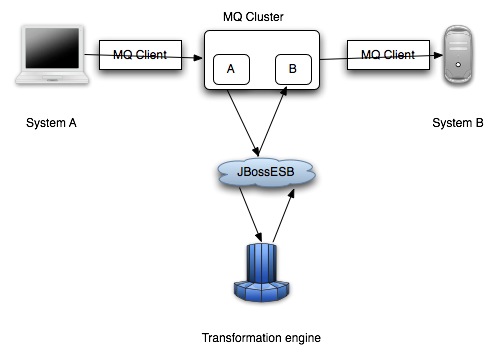
JBossESB can be used in more than multi-party scenarios. For example, the diagram below shows basic data transformation via the ESB using the file system.
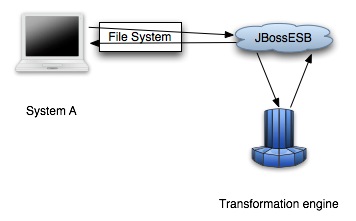
The final scenario is again a single party example using transformation and a queuing system.
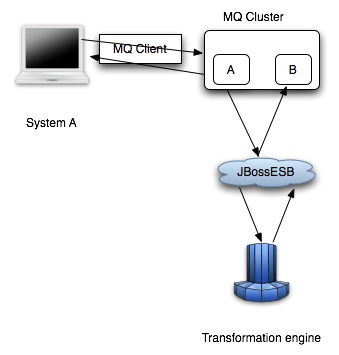
Chapter 4
JBossESB
The core of JBossESB is Rosetta5, an ESB that has been in commercial deployment at a mission critical site for over 3 years. The architecture of Rosetta is shown below in Figure 3:
Note: In the diagram, processor classes refer to the Action classes within the core that are responsible for processing on triggered events.
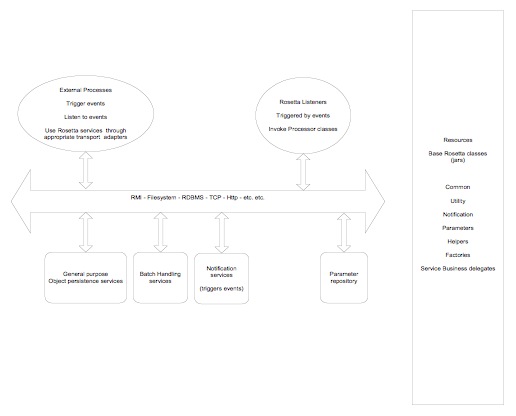
There are many reasons why users may want disparate applications, services and components to interoperate, e.g., leveraging legacy systems in new deployments. Furthermore, as we have seen such interactions between these entities may occur both synchronously or asynchronously. As with most ESBs, Rosetta was developed to facilitate such deployments, but providing an infrastructure and set of tools that could:
Be easily configured to work with a wide variety of transport mechanisms (e.g., email and JMS).
Offer a general purpose object repository.
Enable pluggable data transformation mechanisms.
Provide a batch handling capability.
Support logging of interactions.
To date, Rosetta has been used in mission critical deployments using Oracle Financials. The multi platform environment included an IBM mainframe running z/OS, DB2 and Oracle databases hosted in the mainframe and in smaller servers, with additional Windows and Linux servers and a myriad of third party applications that offered dissimilar entry points for interoperation. It used JMS and MQSeries for asynchronous messaging and Postgress for object storage. Interoperation with third parties outside of the corporation’s IT infrastructure was made possible using IBM MQSeries, FTP servers offering entry points to pick up and deposit files to/from the outside world and attachments in e-mail messages to ‘well known’ e-mail accounts.
As we shall see when examining the JBossESB core, which is based on Rosetta, the challenge was to provide a set of tools and a methodology that would make it simple to isolate business logic from transport and triggering mechanisms, to log business and processing events that flowed through the framework and to allow flexible plug ins of ad hoc business logic and data transformations. Emphasis was placed on ensuring that it possible (and simple) for future users to replace/extend the standard base classes that come with the framework (and are used for the toolset), and to trigger their own ‘action classes’ that can be unaware of transport and triggering mechanisms.
Rosetta is built on three core architectural components:
Message Listener and Message Filtering code. Message Listeners act as “inbound” message routers that listen for messages (e.g. on a JMS Queue/Topic, or on the filesystem) and present the message to a message processing pipeline that filters the message and routes it (“outbound” router) to another message endpoint.
Data transformation via the SmooksTransformer action processor. See the Message Transformation Guide.
A Content Based Routing Service. See the CBR Guide.
A Message Repository, for saving messages/events exchanged within the ESB.
These capabilities are offered through a set of business classes, adapters and processors, which will be described in detail later. Interactions between clients and services are supported via a range of different approaches, including JMS, flat-file system and email.
A typical JBossESB deployment is shown below. We shall return to this diagram in subsequent sections.
Note: Some of the components in the diagram (e.g., LDAP server) are configuration choices and may not be provided out-of-the-box. Furthermore, the Processor and Action distinction shown in the above diagram is merely an illustrative convenience to show the concepts involved when an incoming event (message) triggers the underlying ESB to invoke higher-level services.
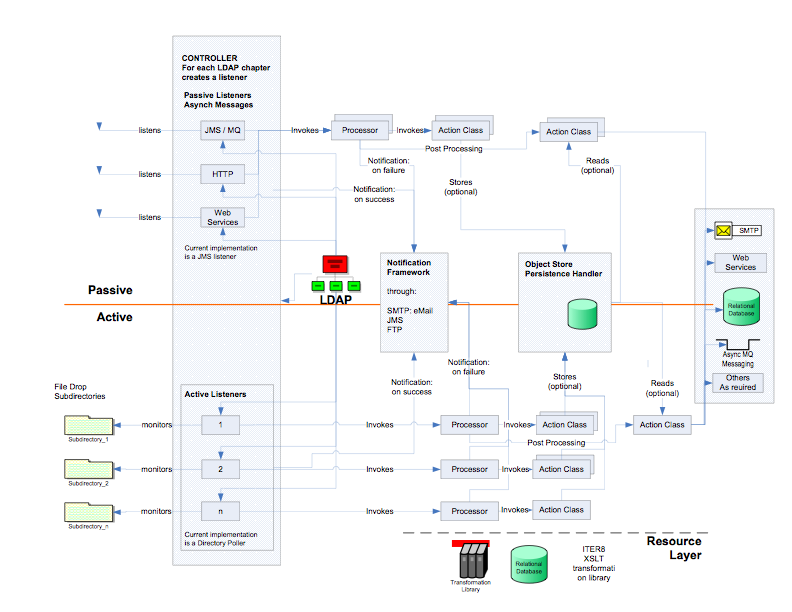
Figure 4: ESB Core components.
In the following sections we shall examine the core components of JBossESB.
All components within the core receive their configuration parameters as XML. How these parameters are provided to the system is hidden by the org.jboss.soa.esb.parameters.ParamRepositoryFactory:
public
abstract class ParamRepositoryFactory
{
public static
ParamRepository getInstance();
}
This returns implementations of the org.jboss.soa.esb.parameters.ParamRepository interface which allows for different implementations:
public
interface ParamRepository
{
public void add(String name,
String value) throws
ParamRepositoryException;
public String get(String name) throws
ParamRepositoryException;
public void remove(String name) throws
ParamRepositoryException;
}
With the beta version of JBossESB, there is only a single implementation, the org.jboss.soa.esb.parameters.ParamFileRepository, which expects to be able to load the parameters from a file. The implementation to use may be overridden using the org.jboss.soa.esb.paramsRepository.class property.
The message store mechanism in JBossESB is designed with audit tracking purposes in mind. As with other ESB services, it is a pluggable service, which allows for you, the developer to plug in your own persistence mechanism should you have special needs. The implementation supplied with JBossESB is a database persistence mechanism. If you require say, a file persistence mechanism, then it’s just a matter of you writing your own service to do this, and override the default behaviour with a configuration change.
One thing to point out with the Message Store – this is a base implementation. We will be working with the community and partners to drive the feature functionality set of the message store to support advanced audit and management requirements. This is meant to be a starting point.
First, let’s discuss the Message Store interface. It is quite simple:
The interface, part of the Rosetta core, is defined as follows:
package
org.jboss.soa.esb.services.persistence;
public interface
MessageStore {
public URI addMessage(Message message);
public
Message getMessage(URI uid) throws Exception;
}
It can read and write messages, returning or taking a standard URI. This URI is used as the “key” for that message in the database, for the default database implementation.
The class which implements this interface, providing the out of the box implementation, can be found in the Services tree under the package org.jboss.internal.soa.esb.persistence.format.db. The methods in this implementation make the required DB connections (using a pooled Database Manager DBConnectionManager), inserting the Message, and retrieving the message.
To configure your Message Store, you can change and override the default service implementation through the following settings found in the jbossesb-properties.xml:
<properties
name="dbstore">
<property
name="org.jboss.soa.esb.persistence.messagestore.factory"
value="org.jboss.internal.soa.esb.persistence.format.MessageStoreFactoryImpl"/>
<property
name="org.jboss.soa.esb.persistence.db.connection.url"
value="jdbc:hsqldb:hsql://localhost:9001/jbossesb"/>
<property
name="org.jboss.soa.esb.persistence.db.jdbc.driver"
value="org.hsqldb.jdbcDriver"/>
<property
name="org.jboss.soa.esb.persistence.db.user"
value="sa"/>
<property
name="org.jboss.soa.esb.persistence.db.pwd"
value=""/>
<property
name="org.jboss.soa.esb.persistence.db.pool.initial.size"
value="2"/>
<property
name="org.jboss.soa.esb.persistence.db.pool.min.size"
value="2"/>
<property
name="org.jboss.soa.esb.persistence.db.pool.max.size"
value="5"/>
<property
name="org.jboss.soa.esb.persistence.db.pool.test.table"
value="pooltest"/>
<property
name="org.jboss.soa.esb.persistence.db.pool.timeout.millis"
value="5000"/>
</properties>
The section in the property file called “dbstore” has all the settings required by the database implementation of the message store. The standard settings, like URL, db user, password, pool sizes can all be modified here.
The scripts for the required database schema, are again, very simple. They can be found under ESB_ROOT/install/message-store/sql/<db_type>/ create_database.sql. Only Hypersonic SQL and PostgresSQL are provided, but you should be able to create your own database specific table definition very easily.
The structure of the table is:
Column
Name Type
uuid TEXT
type TEXT
message text
the uuid column is used to store a unique key for this message, in the format of a standard URI. A key for a message would look like:
urn:jboss:esb:message:UID: + UUID.randomUUID()
This logic uses the new UUID random number generator in jdk 1.5. the type will be the type of the stored message. JBossESB ships with JBOSS_XML and JAVA_SERIALIZED currently.
The “message” column will contain the actual message content.
One of the aims of JBossESB is to allow a wide variety of clients and services to interact. JBossESB does not require that all such clients and services be written using JBossESB or any ESB for that matter. There is an abstract notion of an Interoperability Bus within JBossESB, such that endpoints that may not be JBossESB-aware can still be “plugged in to” the bus.
Note: in what follows, the terms “within the ESB” or “inside the ESB” refer to ESB-aware endpoints.
All JBossESB-aware clients and services communicate with one another using Messages, to be described later. A Message is simply a standardized format for information exchange, containing a header, body (payload), attachments and other data. Furthemore, all JBossESB-aware services are identified using Endpoint References (EPRs), to be described later.
It is important for legacy interoperability scenarios that a SOA infrastructure such as JBossESB allow ESB-unaware clients to use ESB-aware services, or ESB-aware clients to use ESB-unaware services. The concept that JBossESB uses to facilitate this interoperability is through Gateways. A gateway is a service that can bridge between the ESB-aware and ESB-unaware worlds and translate to/from Message formats and to/from EPRs.
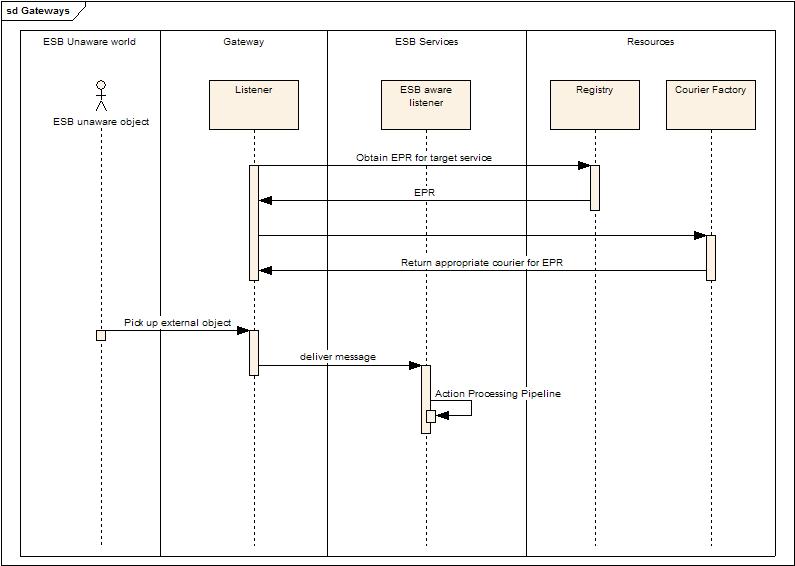
All clients and services within JBossESB are addressed using Endpoint References (EPRs). An EPR has the following XML-based composition:
[address] : URI (mandatory). An address URI that identifies the endpoint. This may be a network address or a logical address.
[reference properties] : xs:any (0..unbounded). A reference may contain a number of individual properties that are required to identify the entity or resource being conveyed. Reference identification properties are element information items that are named by QName and are required to properly dispatch messages to endpoints at the endpoint side of the interaction. Reference properties are provided by the issuer of the endpoint reference and are otherwise assumed to be opaque to consuming applications. The interpretation of these properties (as the use of the endpoint reference in general) is dependent upon the protocol binding and data encoding used to interact with the endpoint. Consuming applications should assume that endpoints represented by endpoint references with different [reference properties] may accept different sets of messages or follow a different set of policies, and consequently may have different associated metadata (e.g., WSDL, XML Schema, and WS-Policy policies ).
[reference parameters] : xs:any (0..unbounded). A reference may contain a number of individual parameters which are associated with the endpoint to facilitate a particular interaction. Reference parameters are element information items that are named by QName and are required to properly interact with the endpoint. Reference parameters are also provided by the issuer of the endpoint reference and are otherwise assumed to be opaque to consuming applications. The use of reference parameters is dependent upon the protocol binding and data encoding used to interact with the endpoint. Unlike [reference properties], the [reference parameters] of two endpoint references may differ without an implication that different XML Schema, WSDL or policies apply to the endpoints.
JBossESB uses the org.jboss.soa.esb.addressing.EPR and org.jboss.soa.esb.addressing.PortReference classes to represent endpoint references.
public
class
EPR
{
public
EPR ();
public EPR (PortReference addr);
public
EPR (URI uri);
public
void
setAddr (PortReference uri);
public
PortReference getAddr () throws
URISyntaxException;
public
void
copy (EPR from);
public
boolean
equals (Object obj);
}
Note: The use of EPRs is based on the WS-Addressing specification from the W3C. However, in the 4.0 release the JBossESB implementation of EPRs is closer to the 2004 version of the specification from IBM, Microsoft et al.
Not all users of JBossESB will be ESB-aware. In order to facilitate those users interacting with services provided by the ESB, JBossESB has the concept of a Gateway: specialised servers that can accept messages from non-ESB clients and services and route them to the required destination.
A Gateway is a specialised listener process, that behaves very similarly to an ESB aware listener. There are some important differences however:
Gateway classes can pick up arbitrary objects contained in files, JMS messages, SQL tables etc (each 'gateway class' is specialized for a specific transport), whereas ESB listeners can only process ESB Messages. However, those Messages can contain arbitrary data.
Only one action class is invoked to perform the 'message composing' action. ESB listeners are able to execute an action processing pipeline.
Objects that are 'picked up' will be used to invoke a single 'composer class' (the action) that will return an ESB Message object, which will be delivered to a target service that must be an ESB aware service. The target service defined at configuration time, will be translated at runtime into an EPR (or a list of EPRs) by the Registry. The underlying concept is that the EPR returned by the Registry is analogous to the 'toEPR' contained in the header of ESB Messages, but because incoming objects are 'ESB unaware' and there is thus no dynamic way to determine the toEPR, this value is provided to the gateway at configuration time and included in all outgoing messages.
There are a few off the shelf composer classes: the default 'file' composer class will just package the file contents into the Message body; same idea for JMS messages. Default message composing class for a SQL table row is to package contents of all columns specified in configuration, into a java.util.Map.
Although these default composer classes will be enough for most use cases, it is relatively straightforward for users to provide their own message composing classes. The only requirements are a) they must have a constructor that takes a single ConfigTree argument, and b) they must provide a 'Message composing' method (default name is 'process' but this can be configured differently in the 'process' attribute of the <action> element within the ConfigTree provided at constructor time. The processing method must take a single argument of type Object, and return a Message value.
All interactions between clients and services within JBossESB occur through the exchange of messages. In order to encourage loose coupling we recommend a message-exchange pattern based on one-way messages, i.e., requests and responses are independent messages, correlated where necessary by the infrastructure or application. Applications constructed in this way are less brittle and can be more tolerant of failures, giving developers more flexibility in their deployment and message delivery requirements.
To ensure loose coupling of services and develop SOA applications, it is necessary to:
Use one-way message exchanges rather than request-response.
Keep the contract definition within the exchanged messages. Try not to define a service interface that exposed back-end implementation choices, because that will make changing the implementation more difficult later.
Use an extensible message structure for the message payload so that changes to it can be versioned over time, for backward compatibility.
Do not develop fine-grained services: this is not a distributed-object paradigm, which can lead to brittle applications.
In order to use a one-way message delivery pattern with requests and responses, it is obviously necessary to encode information about where responses should be sent. That information may be present in the message body (the payload) and hence dealt with solely by the application, or part of the initial request message and typically dealt with by the ESB infrastructure.
Therefore, central to the ESB is the notion of a message, whose structure is similar to that found in SOAP:
<xs:complexType
name="Envelope">
<xs:attribute
ref="Header"
use="required"/>
<xs:attribute
ref="Context"
use="required"/>
<xs:attribute
ref="Body"
use="required"/>
<xs:attribute
ref="Attachment"
use="optional"/>
<xs:attribute
ref="Properties"
use="optional"/>
<xs:attribute
ref="Fault"
use="optional"/>
</xs:complexType>
Pictorially the basic structure of the Message can be represented as shown below. In the rest of this section we shall examine each of these components in more detail.
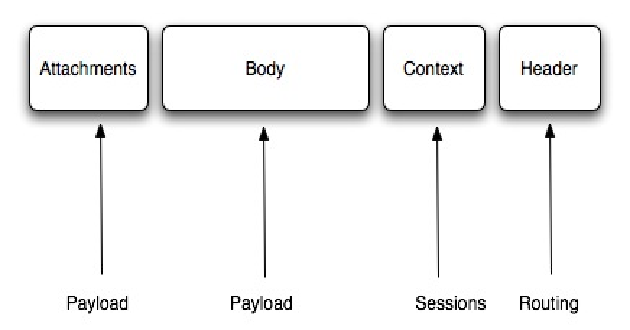
Each message is an implementation of the org.jboss.soa.esb.message.Message interface. Within that package are interfaces for the various fields within the Message as shown below:
public
interface
Message
{
public
Header getHeader ();
public
Context getContext ();
public
Body getBody ();
public
Fault getFault ();
public
Attachment getAttachment ();
public
URI getType ();
public
Properties getProperties ();
}
The Header contains routing and addressing information for this message. As we saw earlier, JBossESB uses an addressing scheme based on the WS-Addressing standard from W3C. We shall discuss the org.jboss.soa.esb.addressing.Call class in the next section.
public
interface
Header
{
public
Call getCall ();
public
void
setCall (Call call);
}
The Context contains session related information, such as transaction or security contexts.
Note: The 4.0 release of JBossESB does not support user-enhanced Contexts. This will be a feature of the next release.
The Body typically contains the payload of the message. It may contain a byte array for arbitrary data. How that array is interpreted by the service is implementation specific and outside the scope of the ESB to enforce. It may also contain a list of Objects of arbitrary types. How these objects are serialized to/from the message body when it is transmitted is up to the specific Object type.
public
interface
Body
{
public
void
add (String name, Object value);
public
Object get (String name);
public
Object remove (String name);
public
void
setContents (byte[]
content);
public
byte[]
getContents ();
public
void
replace (Body b);
public
void
merge (Body b);
}
The Fault can be used to convey error information.
public
interface Fault
{
public
URI getCode ();
public
void
setCode (URI code);
public
String getReason ();
public
void
setReason (String reason);
}
A set of message properties, which can be used to define additional meta-data for the message.
public
interface
Properties
{
public
Object getProperty(String name);
public
Object getProperty(String name, Object defaultVal);
public
Object setProperty(String name, Object value);
public
Object remove(String name);
public
int
size();
public
String[] getNames();
}
Messages may contain attachments that do not appear in the main payload body. For example, binary document formats, zip files etc. The Attachment interface supports both named and unnamed attachments.
public
interface
Attachment
{
Object get(String name);
Object
put(String name, Object value);
Object remove(String
name);
String[] getNames();
Object
itemAt (int
index) throws
IndexOutOfBoundsException;
Object removeItemAt (int
index) throws
IndexOutOfBoundsException
Object replaceItemAt(int
index, Object value)
throws
IndexOutOfBoundsException;
void
addItem (Object value);
void
addItemAt (int
index, Object value)
throws
IndexOutOfBoundsException;
public
int
getNamedCount();
}
As we saw above, the Header of a Message contains a reference to the org.jboss.soa.esb.addressing.Call class:
public
class
Call
{
public
Call ();
public
Call (EPR epr);
public
void
setTo (EPR epr);
public
EPR getTo () throws
URISyntaxException;
public
void
setFrom (EPR from);
public
EPR getFrom () throws
URISyntaxException;
public
void
setReplyTo (EPR replyTo);
public
EPR getReplyTo () throws
URISyntaxException;
public
void
setFaultTo (EPR uri);
public
EPR getFaultTo () throws
URISyntaxException;
public
void
setRelatesTo (URI uri);
public
URI getRelatesTo () throws
URISyntaxException;
public
void
setAction (URI uri);
public
URI getAction () throws
URISyntaxException;
public
void
setMessageID (URI uri);
public
URI getMessageID () throws
URISyntaxException;
public
void
copy (Call from);
}
The properties below support one way, request reply, and any other interaction pattern:
[To] : URI (mandatory). The address of the intended receiver of this message.
[From] : endpoint reference (0..1). Reference of the endpoint where the message originated from.
[ReplyTo] : endpoint reference (0..1). An endpoint reference that identifies the intended receiver for replies to this message. If a reply is expected, a message must contain a [ReplyTo]. The sender must use the contents of the [ReplyTo] to formulate the reply message. If the [ReplyTo] is absent, the contents of the [From] may be used to formulate a message to the source. This property may be absent if the message has no meaningful reply. If this property is present, the [MessageID] property is required.
[FaultTo] : endpoint reference (0..1). An endpoint reference that identifies the intended receiver for faults related to this message. When formulating a fault message the sender must use the contents of the [FaultTo] of the message being replied to to formulate the fault message. If the [FaultTo] is absent, the sender may use the contents of the [ReplyTo] to formulate the fault message. If both the [FaultTo] and [ReplyTo] are absent, the sender may use the contents of the [From] to formulate the fault message. This property may be absent if the sender cannot receive fault messages (e.g., is a one-way application message). If this property is present, the [MessageID] property is required.
[Action] : URI (mandatory). An identifier that uniquely (and opaquely) identifies the semantics implied by this message.
[MessageID] : URI (0..1). A URI that uniquely identifies this message in time and space. No two messages with a distinct application intent may share a [MessageID] property. A message may be retransmitted for any purpose including communications failure and may use the same [MessageID] property. The value of this property is an opaque URI whose interpretation beyond equivalence is not defined. If a reply is expected, this property must be present.
Note: In the 4.0 release of JBossESB not all of the routing and addressing rules are applied by the ESB.
From an application/service perspective the message payload is a combination of the Body and Attachments. In this section we shall give an overview of best practices when constructing and using the message payload.
The byte array component of the Body is a convenience. It allows an un-named and arbitrary encoding of information to be inserted within the payload. It is neither a recommended nor discouraged practice to use the setContents/getContents methods. Neither is the setting of a byte array necessary for inserting named objects within the rest of the payload. The two approaches can be used together or in isolation. The best approach will depend upon the service or application being developed.
More complex content may be added through the add method, which supports named Objects. Names must be unique on behalf of a given Message or an appropriate exception will be thrown. Using <name, Object> pairs allows for a finer granularity of data access. The type of Objects that can be added to the Body can be arbitrary: the do not need to be Java Serializable. However, in the case where non-Serializable Objects are added, it is necessary to provide JBossESB with the ability to marshal/unmarshal the Message when it flows across the network. See the section of Message Formats for more details.
Caution: we discourage the general use of Serialized Java objects in messages because it constrains the service implementations. Use with care.
In general you will find it easier to work with the Message Body through the named Object approach. You can add, remove and inspect individual data items within the Message payload without having to decode the entire Body. Furthermore, you can combine named Objects within the payload with the byte array.
Attachments are additional information that flows with the message but is not embedded within the Body. Although ESB meta-data may be encoded within an attachment, e.g., security tokens, this is not their normal use case: attachments should be considered an adjunct to the Body. As with the Body, Attachments can be uniquely named. Furthermore it is possible to iterate over all of a message's attachments.
Attachments can be used to contain data that naturally represents a resource in its own right or which is cumbersome to represent within the primary message body. The latter can be due to the size, type, or format of the data; a secondary part may be an audio clip, an image, or a very large view of a database, for example.
While the attachment relationship is expected to be commonly used, the model makes no assumption about the nature of the semantic relationship between the primary message body and attachments, or between attachments in the same message.
The compound message structure model does not require that a receiver process, dereference, or otherwise verify any attachment parts of a compound message structure. It is up to the receiver to determine, based on the processing context provided by the primary message Body, which operations must be performed (if any) on the attachment(s).
Note: in the 4.0 release of JBossESB only Java Serialized objects may be attachments. This restriction will be removed in the next release.
Internally to an ESB component, the message is a collection of Java objects. However, messages need to be serialized for a number of reasons, e.g., transmitted between address spaces (processes) or saved to a persistent datastore for auditing or debugging purposes. The external representation of a message may be influenced by the environment in which the ESB is deployed. Therefore, JBossESB does not impose a specific normalized message format, but supports a range of them.
All implementations of the org.jboss.soa.esb.message.Message interface are obtained from the org.jboss.soa.esb.message.format.MessageFactory class:
public
abstract
class
MessageFactory
{
public
abstract
Message getMessage ();
public
abstract
Message getMessage (URI type);
public
static
MessageFactory getInstance ();
}
Message serialization implementations are uniquely identified by a URI. The type of implementation required may be specified when requesting a new instance, or the configured default implementation may be used. Currently JBossESB provides two implementations, which are defined in the org.jboss.soa.esb.message.format.MessageType class:
MessageType.JBOSS_XML: this uses an XML representation of the Message on the wire. The schema for the message is defined in the message.xsd within the schemas directory.
MessageType.JAVA_SERIALIZED: this implementation requires that all components of a Message are Serializable. It obviously requires that recipients of this type of Message have sufficient information (the Java classes) to be able to de-serialize the Message.
Other Message implementations may be provided at runtime through the org.jboss.soa.esb.message.format.MessagePlugin:
public
interface
MessagePlugin
{
public
static
final
String MESSAGE_PLUGIN
=
"org.jboss.soa.esb.message.format.plugin";
public
Message getMessage ();
public
URI getType ();
}
Each plug-in must uniquely identify the type of Message implementation it provides (via getMessage), using the getType method. Plug-in implementations must be identified to the system via the jbossesb-properties.xml file using property names with the org.jboss.soa.esb.message.format.plugin extension.
As mentioned previously, JBossESB supports two serialized message formats: MessageType.JBOSS_XML and MessageType.JAVA_SERIALIZED. In the following sections are shall look at each of these formats in more detail.
This implementation requires that all contents are Java Serializable. Any attempt to add a non-Serializable object to the Message will result in a IllegalParameterException being thrown.
This implementation uses an XML representation of the Message on the wire. The schema for the message is defined in the message.xsd within the schemas directory. Arbitrary objects may be added to the Message, i.e., they do not have to be Serializable. Therefore, it may be necessary to provide a mechanism to marshal/unmarshal such objects to/from XML when the Message needs to be serialized. This support can be provided through the org.jboss.soa.esb.message.format.xml.marshal.MarshalUnmarshalPlugin:
public
interface
MarshalUnmarshalPlugin
{
public
static
final
String MARSHAL_UNMARSHAL_PLUGIN
=
"org.jboss.soa.esb.message.format.xml.plugin";
public
boolean
marshal (Element doc, Object param)
throws
MarshalException;
public
Object unmarshal (Element doc) throws
UnmarshalException;
public
URI type ();
}
Note: Java Serialized objects are supported by default.
Plug-ins can be registered with the system through the jbossesb- properties.xml configuration file. They should have attribute names that start with the MARSHAL_UNMARSHAL_PLUGIN. When packing objects in XML, JBossESB runs through the list of registered plug-ins until it finds one that can deal with the object type (or faults). When packing, the name (type) of the plug-in that packed the object is also attached to facilitate unpacking at the Message receiver.
Often clients and services will communicate using the same vocabulary. However, there are situations where this is not the case and on-the-fly transformation from one data format to another will be required. It is unrealistic to assume that a single data format will be suitable for all business objects, particularly in a large scale or long running deployment. Therefore, it is necessary to provide a mechanism for transforming from one data format to another.
In JBossESB this is the role the Transformation Service. This version of the ESB is shipped with an out-of-the-box Transformation Service based on Milyn Smooks. Smooks is a Transformation Implementation and Management framework. It allows you implement your transformation logic in XSLT, Java etc and provides a management framework through which you can centrally manage the transformation logic for your message-set.
For more details see the Message Transformation Guide.
Listeners encapsulate the endpoints for message reception. Upon receipt of a message, a Listener feeds that message into a “pipeline” of message processors that process the message before routing the result to the “replyTo” endpoint. The action processing that takes place in the pipeline may consist of steps wherein the message gets transformed in one processor, some business logic is applied in the next processor, before the result gets routed to the next step in the pipeline, or to another endpoint. Listeners rely on the Courier interface to pick up and deliver Messages.
The Courier interface encapsulates transport details from listeners.
public
interface
Courier
{
public
boolean
deliver(Message message) throws
CourierException;
}
The TwoWayCourier class that extends Courier, can also pickup Messages from an EPR. It is useful when a response is expected from the target of the outgoing Message (see for example org.jboss.soa.esb.actions.CbrProxyAction).
public
interface
TwoWayCourier extends
Courier
{
...
public
Message pickup(long
waitTime, EPR epr) throws
CourierException, CourierTimeoutException;
...
}
The CourierFactory class will return an appropriate Courier (or TwoWayCourier) class for specific EPRs.
public
class
CourierFactory
{
....
public
static
Courier getCourier(EPR toEPR) throws
CourierException
{
...
}
public
static
TwoWayCourier getCourier(EPR toEPR, EPR replyToEPR)
throws
CourierException
{
...
}
...
}
The default internal TwoWayCourierImpl checks if the transport specific courier has a public 'void cleanup()' method and if so, invokes it to do housekeeping that need not be implemented for all transports. See org.jboss.internal.soa.esb.couriers.JmsCourier for example.
Transport specific classes that implement the Courier or TwoWayCourier interfaces can publish other utility methods that are specific for that particular transport.
As outlined above, the responsibility of a listener is to act as a message delivery endpoint and to deliver messages to an “Action Processing Pipeline”. Each listener configuration needs to supply information for:
the Registry (see service-category, service-name, service-description and EPR-description tag names)
instantiation of the listener class (see listenerClass tag name)
the EPR that the listener will be servicing. This is transport specific. The following example corresponds to a JMS EPR (see connection-factory, destination-type, destination-name, jndi-type, jndi-URL and message-selector tag names)
the “action processing pipeline”. One or more <action> elements each that must contain at least the 'class' tagname that will determine which action class will be instantiated for that step in the processing chain
<ExampleActionConfig
service-category="my category"
service-name="testJmsGateway"
service-description="My Example Service Name (optional)"
epr-description="Verbose (optional) description of the EPR"
listenerClass="org.jboss.soa.esb.listeners.message.JmsQueueListener"
connection-factory="ConnectionFactory"
destination-type="queue"
destination-name="queue/A"
jndi-type="jboss"
jndi-URL="localhost"
message-selector="serviceId='xyz'"
>
<!-- -->
<action class="org.jboss.soa.esb.listeners.gateway.JmsGatewayListenerUnitTest$MockMessageAwareAction" process="writeToDisk" />
<action class="org.jboss.soa.esb.actions.Notifier" okMethod="notifyOK">
<NotificationList type="OK">
<target class="NotifyConsole" />
</NotificationList>
</action>
</ExampleActionConfig>
This example configuration will instantiate a JmsQueueListener object (listenerClass attribute) that will wait for inconimg ESB Messages, serialized within a javax.jms.ObjectMessage, and will deliver each incoming message to an ActionProcessingPipeline consiting of two steps (<action> elements):
A MockMessageAwareAction (a trivial example follows)
An org.jboss.soa.esb.actions.Notifier (thar replaces the NotificationHandler EJB of the Beta 1) the child <NotificationList> element is ignored by the pipeline, but passed to and used only by the class specified in the 'class' attribute
The following trivial action class will prove useful for debugging your XML action configuration
public
class
MockMessageAwareAction
{
ConfigTree _config;
public
MockMessageAwareAction(ConfigTree config) { _config
= config; }
public
Message process (Message message) throws
Exception
{
System.out.println(message.getBody().getContents());
return
message;
}
}
Action classes are the main way in which ESB users can tailor the framework to their specific needs. The ActionProcessingPipeline class will expect any action class to provide at least the following:
A public constructor that takes a single argument of type ConfigTree
One or more public methods that take a Message argument, and return a Message result
Optional public callback methods that take a Message argument will be used for notification of the result of the specific step of the processing pipeline (see items 5 and 6 below).
The org.jboss,soa.esb.listeners.message.ActionProcessingPipeline class will perform the following steps for all steps configured using <action> elements
Instantiate an object of the class specified in the 'class' attibute with a constructor that takes a single argument of type ConfigTree
Analyze contents of the 'process' attribute.
Contents can be a comma separated list of public method names of the instantiated class (step 1), each of which must take a single argument of type Message, and return a Message object that will be passed to the next step in the pipeline
If the 'process' attribute is not present, the pipeline will assume a single processing method called “process”
Using a list of method names in a single <action> element has some advantages compared to using successive <action> elements, as the action class is instantiated once, and methods will be invoked on the same instance of the class. This reduces overhead and allows for state information to be kept in the instance objects.
This approach is useful for user supplied (new) action classes, but the other alternative (list of <action> elements) continues to be a way of reusing other existing action classes.
Sequentially invoke each method in the list using the Message returned by the previous step
If value returned by any step is null, a warning message will be logged, the pipeline will stop processing, and no Message will be returned to the 'replyToEPR'
Callback method for success in each <action> element: If the list of methods in the 'process' attribute was executed successfully, the pipeline will analyze contents of the 'okMethod' attribute. If none is specified, processing will continue with the next <action> element. If a method name is provided in the 'okMethod' attribute, it will be invoked using the Message returned by the last method in step 3
Callback method for failure in each <action> element: If an Exception was thrown at any point in the pipeline, processing will be interrupted at that point, an error message will be logged, and contents of the 'exceptionMethod' tag will be analyzed and if present in the current action class, the method will be invoked using the Message returned by the last method in step 3 . At present time, if no exceptionMethod was specified, the only output will be the logged error. Upcoming releases will route the Message to the faultTo EPR contained in the Message.
Action classes supplied by users to tailor behaviour of the ESB to their specific needs, might need extra run time configuration (for example the Notifier class in the XML above needs the <NotificationList> child element). Each <action> element will utilize the attributes mentioned above and will ignore any other attributes and optional child elements. These will be however passed through to the action class constructor in the require ConfigTree argument. Each action class will be instantiated with it's corresponding <action> element and thus does not see (in fact must not see) sibling action elements.
Chapter 5
Configuration
With the exception of the ESB-aware listeners and gateways, the core of JBossESB is configured through the jbossesb-properties.xml file. This file is broken into sections, where each section of properties is concerned with a different aspect of configuring JBossESB.
Index
Architectural components 24
Configuring JBossESB 25
ESB Overview 14
Format adapters 36
JBossESB
Access Control Lists 15
contract definition language 17
implementation flexibility 15
multi-bus support 17
Rosetta
history 24
SOA Overview 8
SOA Overview
basics 11
benefts 9
Why SOA? 10
1 The principles behind SOA have been around for many years, but Web Services have popularised it.
2 It is possible to build non-SOA applications using Web Services.
3 Actually true asynchrony is often not necessary: synchronous one-way (void returns) RPCs can be used and often are in Web Services.
4 Services may be available via multiple different protocols simultaneously, e.g., CORBA IIOP and JMS. A service repository (aka Name Service/Trading Service) will maintain service identities with their endpoint references and contract definitions (CORBA IDL, WSDL, etc.)
5 Rosetta borrowed its name from the stone found in 1799 by French soldiers in the Nile delta’s town of Rosetta (French for Rashid) that was instrumental in Jean-François Champollion deciphering of Egyptian hieroglyphs.
JBESB-PG-